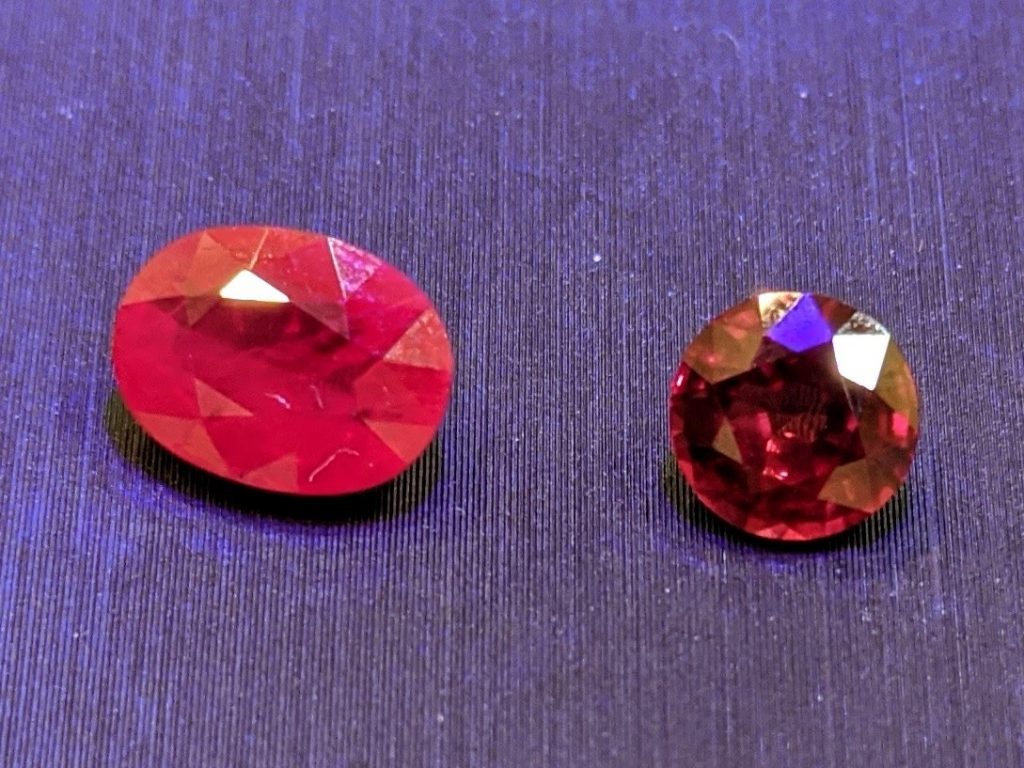Meaning Behind Rubies
What is the spiritual meaning behind a ruby?
U11962 | right | medium | play | “Ruby ID: U11962 – Weight: 1.78 – Origin: Myanmar (formerly Burma)”Rubies and their red is considered to be a passionate color with lots of energy whether it relates to love or war. It is widely considered to be the color of powerful feelings, liveliness even. Some customs follow that it is able to dispel entities that leech positive energy, thus promoting your own spiritual vitality. From the West to the far reaches of the East, red is one of the most popular and attractive colors.


Burma in particular has a large culture around rubies. As the historic producer they had so many rubies that even their old buildings have rubies buried under the foundations to ward off evil and ill omens.
Protective Amulets

Many amulets use gemstones as protective talismans with different properties. Some use multiple gems like a navaratna (picture left) amulet. This one is widely recognized across southern and south-eastern Asian cultures and religions, using 9 different gems. One stone is placed at the center surrounded by the 8 other gems, each one relating to a specific divine power whether it be a god, planet, or cosmic energies depending on the religion. Out of all of them, it is the ruby that goes in the center to represent the sun rather than something like diamond.
Rubies in the Bible
Rubies have a place in western culture too. The English word passion is also used to refer to “The Passion of Christ”, a specific period towards the end of Christ’s life in the New Testament. The most iconic part of this section culminates in his crucifixion, a very bloody, very painful punishment. The deep scarlet hue of rubies is associated with his blood, his “passion”.
Aside from the red color being prized amongst Kings, it is coveted by the church, adorning many of their most highly prized items and symbols. At various other points in the bible, rubies are used as a measure of value.



“For wisdom is better than rubies; and all the things that may be desired are not to be compared to it.”- Proverbs 8:11
“Who can find a virtuous woman? For her price is far above rubies.” – Proverbs 31:10-31
Practical Factors of a Rubies Spirituality
For any colored gemstone, vivid reds always seem to be the most popular color from fluorite to diamonds. Ruby was historically used to describe any red gemstone, not the specific corundum variety with specific conchoidal fractures, inclusions, density, growth habits habits etc. Distinction between different red stones like between rubies, spinel, garnets, etc. Distinction between different red stones like rubies, spinel, garnets, etc, did not occur until roughly the late 1800s and public understanding came later. One famous example is the Black Prince Ruby that currently resides in the imperial crown of Britain, which is not a ruby but a spinel. Spinels are very similar to rubies due to the specific color of red they reach, and their fluorescence.



This fluorescence is caused by UV (ultraviolet) rays, and makes the stone glow red. In other words, it makes the ruby light-up from the inside like there is a fire within. It makes sense that rubies are so commonly compared to the sun.
Other characteristics of corundum rubies is that they have a conchoidal (curved, step-like) fracture, are tougher than most other red gems, and have a high hardness that give them a sub-adamantine luster (means they are particularly reflective, or shiny). This durability is probably where the concept of invulnerability in rubies comes from, since other red stones like fluorite lack toughness and break easily. Other tough stones like garnets don’t quite match up to the toughness of rubies, and are frequently dark. Spinels (MgAl2O4) are the most similar with the soft, glowing fluorescence and vivacious color; partially because they have a very similar chemical composition to corundum (Al2O3). However, they are not as hard, dense, and lustrous (reflective) as rubies.

The only gemstone to meet and exceed rubies in terms of durability and luster is diamonds. However, diamonds that reach “ruby red” are extremely rare. The largest one ever found and cut was the Moussaieff Red at 5.11 carats, commanding one of the highest prices of any diamond in the world at 7 million dollars USD. Despite only being 5 carats, its per-carat price is over a million dollars a carat like the 25 carat Sunrise Ruby. However, the red color is not the same as it is in rubies.

